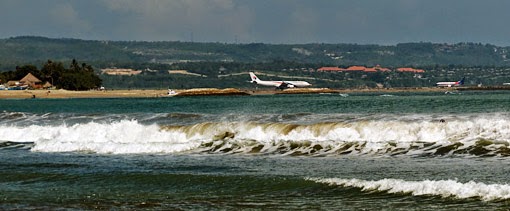Airports in Indonesia: Bali’s Ngurah Rai World’s 3rd-Best Airport


Ngurah Rai International Airport seen from the Kuta beach.
Jakarta, 02 Jumadil Akhir 1438/01 March 2017 (MINA) – Airport Councils International, the only worldwide trade representative of the world’s airports, considers Bali’s I Gusti Ngurah Rai International Airport the world’s third-best airport in the category “airports with an annual passenger capacity of 15-25 million people in 2016”.
The airport’s score improved from 4.74 in the 2015 edition to 4.92 in the latest edition. To continue improving its performance, the airport operator will continue to invest in airport facilities as well as supporting infrastructure, indonesian-investment.com reported Tuesday.
Currently, state-owned airport operator of I Gusti Ngurah Rai International Airport, that is Angkasa Pura I, is preparing the arrival of King Salman bin Abdulaziz Al Saud of Saudi Arabia, who has confirmed that he will visit Bali between 4-9 March 2017.
Reportedly, he will have an entourage of around 1,500 men in seven Boeing 747s. These wide-body airplanes need to park at Ngurah Rai’s parking lot and therefore several airplanes of Sriwijaya Air will be moved to Juanda Airport in Surabaya (East Java).
When the Saudi king arrives on 4 March there is also a big chance that commercial flights that are scheduled to arrive or depart within 25 minutes after the king’s arrival will experience a short delay.
Indonesia’s Ministry of Transportation expects the number of air passengers in Indonesia to rise 5 percent (y/y) to 118 million in 2017.
Budi Karya, Indonesian Minister of Transportation, said accelerating economic growth and controlled inflation should boost demand for flights in 2017.
New strategy
The government also announced a new strategy: in order to be able to welcome more foreign tourists the state airport operators will allow less domestic flights to arrive and depart at Indonesia’s two busiest airports: Soekarno-Hatta International Airport (just outside Indonesia’s capital city of Jakarta) and I Gusti Ngurah Rai International Airport on Bali.
The government implemented this strategy as it is eager to boost the number of foreign tourists arrivals in Indonesia in order to generate more foreign exchange earnings.
In full-year 2016 the number of air passengers in Indonesia reached 112 million, up 6 percent from air passenger realization in the preceding year.
Around 89 million (roughly 80 percent) were domestic passengers, while the remaining 23 million were foreign passengers (20 percent). However, the government wants to change this 80:20 ratio (domestic:foreign passengers) to 75:25 in 2017.
In order to absorb rising passenger numbers (particularly caused by the expanding business of low-cost carriers), it is important to invest in infrastructure in order to guarantee a smooth flow of airplanes and passengers.
A key problem in the whole economy of Indonesia is that robust economic growth, particularly during the 2000s commodities boom, was not followed by robust infrastructure development and therefore there has emerged an economy that is inefficient to a high degree, characterized by matters such as high logistics costs. (T/RS05/RS01)
Mi’raj Islamic News Agency (MINA)



